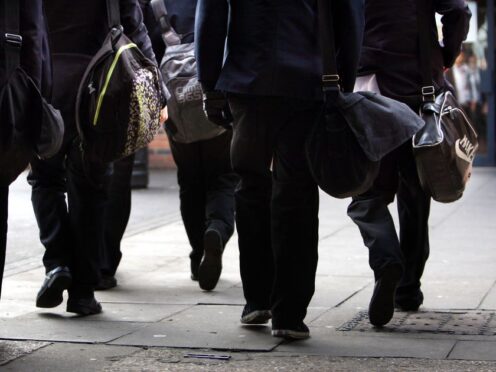Education Secretary Jenny Gilruth has branded the number of pupils missing school “not acceptable” as new figures showed a drop in attendance rates.
She hit out after statistics showed that in 2022-23 almost a third (32.5%) of pupils were classed as being “persistent absentees” – meaning they had missed 10% or more of all sessions.
The figures, published by the Scottish Government, also showed the overall school attendance rate fell to 90.2% in 2022-23 – down from 92% in 2020-21.
The report revealed that while attendance rates had increased to 93.7% in 2014-15, there had been consecutive decreases since then.
The largest drop was from 92% in 2020-21 to 90.2% in 2022-23, it said.
Ms Gilruth said: “The rates of persistent absence highlighted in these figures are not acceptable
“I am absolutely clear that there must be a renewed drive across all levels of governments and agencies to address this as a priority.”
Ms Gilruth has now told Scotland’s Chief Inspector for Education to “ensure that persistent absence is addressed at every school inspection”, along with identifying successful methods of tackling the problem, so these can be shared more widely.
The Education Secretary also said she would this week bring together members of the Scottish Advisory Group on Relationships and Behaviour – which includes local authority leaders, council education directors, Education Scotland and others – to “focus on persistent school absence”.
It comes as the latest figures revealed schools had an increase in both authorised and unauthorised absences.
Sickness was the most common reason for authorised absences, while truanting was the biggest reason for pupils having unauthorised absences.
However the report added that the “biggest contributor to the increase in unauthorised absence from 2020-21 to 2022-23 was unauthorised holidays”, with more parents opting to take their children away during term time.

Pupils in the poorest parts of Scotland had a lower attendance rate than those youngsters in the most affluent communities, the report revealed – with an attendance rate of 86.8% in the most deprived parts of Scotland compared with 93.5% in the least deprived areas.
Ms Gilruth said: “We know that absence is among the post-pandemic challenges facing schools internationally and Scotland is not immune from that.
“Education Scotland has already offered support to schools to improve attendance and reduce absence, following publication of the Improving Attendance report which I commissioned last year.”
She added: “Scotland’s education system continues to perform well, despite the challenges of recent years, with the most recent figures showing record highs in expected literacy and numeracy levels among primary pupils, while a record number of school leavers are getting into work, training or further study.”
Ms Gilruth said that as a “first priority” the Scottish Government was working with councils to “return attendance to pre-Covid levels and to reduce persistent absence as far as possible”.
But Conservative education spokesperson Liam Kerr said: “These highly concerning statistics expose how many pupils have been abandoned on the SNP’s watch.”
He insisted the number of children who were persistently absent was “deeply alarming” with the Tory hitting out at the SNP’s record of “persistent failure” on education.
Mr Kerr said: “They have allowed violence to spiral out of control and have presided over a widening attainment gap.
“SNP ministers should be ensuring our classrooms are safe places to learn and pull out all the stops to guarantee our young people are not missing out on an education to help develop them for later life.”
Meanwhile Labour education spokesperson Pam Duncan-Glancy said: “It is clear for all to see that the SNP government is failing to support Scotland’s teachers and school staff – with pupils paying the price.”
She said the education system is now “under immense pressure”, adding: “Classrooms are like pressure cookers with staff and teacher workloads soaring, more early career teachers in precarious work, more pupils struggling in class and displaying poor behaviour and many more pupils not attending at all.
“Soaring absence rates and rising numbers of ASN pupils demand action to support Scotland’s schools.”
As well as the fall in school attendance rates, the figures also showed an increase in exclusions – with these having increased by 40% over just two years.
According to the data there were 11,676 occasions when pupils had to be excluded in 2022-23 – up by 3,353 from the 8,323 exclusions that were imposed in 2020-21.
The total was still significantly lower than the high of 44,794 that was recorded in 2006-07.
Meanwhile the figures showed the rise in the number of pupils with additional support needs (ASN) continued, with 259,036 youngsters – 37% of all school students – in this category in 2023.
This is up from 34.2% the previous year, with the number of such students said to have “increased markedly since 2010”, according to the report.
Overall the number of students in Scotland’s schools fell slightly, going from 705,874 in 2022 to 705,528 in 2023 – a drop of 346.
Teacher numbers also fell, decreasing by 160 to 54,033 in 2023.
With the number of children and teachers in primary schools both falling, the pupil teacher ratio remained at 15.3.
But in secondary schools the rise in the number of students was “slightly higher proportionally” than the increase in teachers, meaning the pupil teacher ratio rose from 12.4 to 12.5 in 2023.
Meanwhile there were 15 local authority areas where the number of teachers increased – with Dundee City Council seeing a 3.1% rise in its teaching staff, with 42 more full-time equivalent (FTE) teachers in 2023 than it had in 2022.
However in 17 council areas the number of teachers decreased, with a 2.7% fall in East Ayrshire meaning 33 fewer FTE teachers, and both Glasgow City Council and Moray Council seeing teacher numbers drop by 2% – meaning 114 and 19 fewer FTE teachers respectively.
